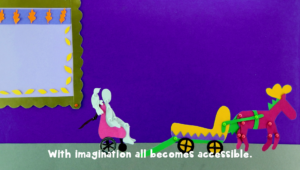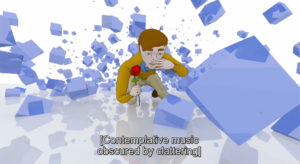



From 24 March to 6 April, our online streaming platform the Cinema of Ideas is hosting Visibly Animated: a film season shining a light on disability representation and accessibility in animation, curated by freelance programmer Louise M. Milsom.
Matchbox Cine has produced hard-of-hearing captions for all the films and talks featured in the programme. In this blog, Matchbox’s Access Consultant Charlotte Little explains the importance of descriptive subtitles in creating a more equal experience for audiences.
I work as an access consultant in the film exhibition sector and I’m a film-lover with access needs. I’m hard of hearing, so I need descriptive subtitles to truly experience and enjoy a film. When it comes to accessible cinema, we still have a long way to go in ensuring films are inclusive and accessible to all audiences. While we’re seeing progress in the provision of access materials such as descriptive subtitles and audio description for film screenings — resistance, ableist attitudes, and misunderstandings around these tools are still prevalent in the wider industry. Part of the issue is that there’s still a lack of awareness around the difference between subtitles and descriptive subtitles, and how the additional information provided through descriptive subtitling is essential for many with hearing loss or auditory processing disorder, who require descriptive labels in order to have an equal viewing experience.
So first of all, what even are descriptive subtitles?
When a film has subtitles, this means that the on-screen text is just a translation of dialogue. A film featuring international languages would have subtitles, providing a translation for audiences who don’t understand the featured language(s).
Descriptive subtitles, sometimes referred to as SDH (subtitles for Deaf and hard-of-hearing), HoH (hard-of-hearing), and captions, transcribe dialogue (e.g. for English speaking audiences, both English and any other languages) and relevant aspects of the soundtrack, including music and sound effects, attempting to give Deaf and hard-of-hearing viewers an equal experience to those who are able to watch films without descriptive subtitles. Descriptive subtitles would include speech identifiers and descriptive elements such as [door slamming] and [kettle whistling]. There are complexities, nuances, and a technical, judgement-based process when it comes to the production of descriptive subtitles, but that’s the difference between subtitles and descriptive subtitles in a nutshell.

Because of the industry-wide interchangeable use of terms such as subtitles and captions, it’s often forgotten that descriptive elements are essential and integral to an accessible viewing experience, and that transcribing dialogue into subtitles isn’t enough for audiences with hearing loss.
As a hard-of-hearing person, I don’t always hear important off-screen or non-dialogue sounds, and I can’t always make out the lyrics to a song playing. If I’m watching a horror film and there’s an eerie, quiet scream in the background, I won’t necessarily be able to hear and understand that sound, so having that descriptive label in the subtitles is important so that I can better appreciate the tone and atmosphere of the scene.
I often come across films and videos online that have English subtitles, but not descriptive subtitles. For films that don’t have any dialogue, it’s even more important to describe the audio atmosphere so that those with hearing loss can better understand the soundscape. The soundtrack can be fundamental to a film’s experience and enjoyment.

When it comes to animation, descriptive subtitles are imperative. Animation can break rules of reality, and there are many animated children’s films that rely on the soundtrack and visuals, rather than spoken dialogue. As a child, I struggled to engage with animated films and cartoons as it was rare to come across subtitles, let alone descriptive subtitles. For me, watching a film without descriptive labels means that I might miss or misunderstand scenes and plot points if the soundtrack, music, or sound effects play a significant role in the audience’s interpretation. A scene might have no dialogue, but the music may create a completely contrasting tone to the visuals on the screen. If there’s not a label with that music describing what tone it strikes, then I’m not having an equal experience to someone who doesn’t need descriptive subtitles.
The presence of descriptive labels creates a much richer, fuller connection to a film, as there’s more substance and depth with which to engage with it, and sound can help form another layer of thematic interpretation. For animated films where the protagonists are animals or non-speaking humans, the soundtrack is often a focal point for viewers. Descriptive subtitles attempt to create an equal viewing experience and the access materials for animated films, and all films, must represent that ethos.

One of the short films featured in Visibly Animated, All for Claire (dir. Simon McKeown), is an avant-garde motion capture film that doesn’t have dialogue, but sound effects are a crucial component of the film’s experience. Rather than watching this film with subtitles, of which there would be none due to the absence of dialogue, descriptive subtitles contribute a greater, visceral understanding of the filmmaker’s work. As the soundscape is interwoven with the visual landscape, the two are often a part of each other.
The difference between subtitles and descriptives can have a drastic impact on an audience member – subtitles assume that the audience can hear. Both subtitles and descriptive subtitles are created with access in mind, but a focus on subtitles can exclude some audiences. Descriptive subtitles are a way for me to experience and engage with film and cinema. Their absence creates a barrier for me that I cannot overcome.
Charlotte Little is an access consultant with expertise in inclusion and access for Disabled and Deaf audiences in film exhibition. Charlotte is hard of hearing and visually impaired, and brings her lived experiences as a disabled moviegoer to her professional work as a consultant. She specialises in advising on venue access, accessible social media, accessible marketing, disability awareness, and outreach. Among many others, Charlotte has worked with Birds Eye View, Belmont Filmhouse, Edinburgh Filmhouse, Sundance London, SQIFF, Bohemia Media, Film Access Scotland, Film Hub Scotland, HippFest and Havana Glasgow Film Festival. Charlotte is also the founder of Caption This Cinema, a pop-up dedicated to inclusive cinema experiences for disabled audiences and diverse programming.
Visibly Animated is available to stream on the Cinema of Ideas until 6 April 2022.